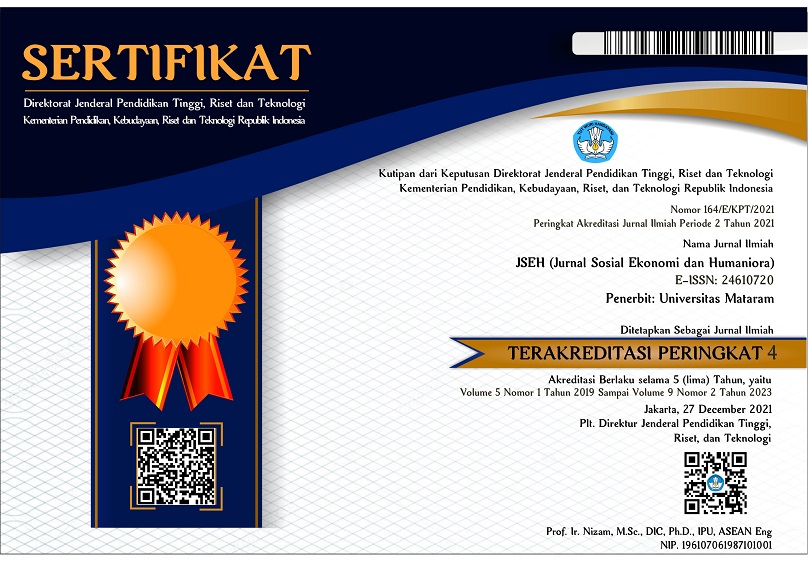Peran Kawasan Ekonomi Khusus Mandalika Lombok Terhadap Pengembangan Ekonomi Lokal (PEL)
DOI:
https://doi.org/10.29303/jseh.v8i1.17Keywords:
Special Economic Area, Local Economic Development (PEL)Abstract
Mandalika Special Economic Area (KEK) has resonated as a national priority tourism center. ITDC as the regional implementing operator is building various facilities in the region. The large investment in the Mandalika area is certainly encouraging as well as alarming. This research is to explore deeply by identifying various business opportunities that can be developed at Mandalika Lombok KEK and strategizing local economic development around the Mandalik area. So that the specific target in this study is to give birth to the Local Economic Development Model in Mandalika Lombok KEK.
The research was conducted qualitatively, data obtained from: Literature And Field Data Study with informants interviewed: 1). Business actors around Mandalika KEK, 2). Tourism activists, 3). Academics in tourism. From the results of the study can be described as follows: (a). The economic condition of the people in and around mandalika kek showed an increase in income before the covid pandemic, but decreased during the pandemic, (b) The economic condition of UMK in and around Kek Mandalika showed an increase in income before the covid pandemic, but decreased during the pandemic, (c). Local Economic Development that can be applied with the Mandalika KEK, can be done with the development of clusters with PEL categories in the field of Tourism, Art Market, lodging services and Creative Industries
References
Adachi, Y. (2018). Applicability of agglomeration to tourism economics. Japan and the World Economy, 47-67. https://doi.org/10.1016/j.japwor.2018.04.002
Amir, S., Osman, M. M., Bachok, S., & Ibrahim, M. (2015). Sustaining Local Community Economy Through Tourism: Melaka UNESCO World Heritage City. Procedia Environmental Sciences, 28 (SustaiN 2014), 443–452. https://doi.org/10.1016/j.proenv.2015.07.054
Arumsani, D dan Pamungkas, A, 2014. Faktor yang Berpengaruh dalam Pengembangan Ekonomi Lokal Berbasis Perikanan di Pulau Poteran. Jurnal Teknik ITS, Vol 3, Iss 2(2014)
Blakely E J Dan Bradshaw, T K, 2002. Planning Economics Development: Theory And Practice. Thousan Oaks, London, New Delhi: Sage Publication.
Boccella, N., & Salerno, I. (2016). Creative Economy, Cultural Industries and Local Development. Procedia - Social and Behavioral Sciences, 223, 291–296. https://doi.org/10.1016/j.sbspro.2016.05.370
Comerio,N.,Pacicco,F., & Serati, M. (2020). Ananalysis of sub-national tourism in Japan: Tourist and economic spillovers and their determinants. Annalysis of Tourism Research, 85 (October 2019), 102881. https://doi.org/10.1016/j.annals.2020.102881
Cristian-Constantin, D., Radu-Daniel, P., Daniel, P., Georgiana, C. L., & Igor, S. (2015). The Role of SPA Tourism in the Development of Local Economies from Romania. Procedia Economics and Finance, 23 (October 2014), 1573–1577. https://doi.org/10.1016/s2212-5671(15)00400-1
Fletcher, R. (2011). Sustaining tourism, sustaining capitalism? The tourism industry’s role in global capitalist expansion. Tourism Geographies, 13(3), 443–461. https://doi.org/10.1080/14616688.2011.570372
Haryati, H. 2018. Pengembangan Ekonomi Lokal Yang Berorientasi Pada Penyerapan Tenaga Kerja Di Provinsi Jawa Timur. Ekuitas: Jurnal Ekonomi Dan Keuangan, Vol 14, Issue 2, Pp 245-269 (2018)
Gao, J., Ryan, C., Cave, J., & Zhang, C. (2019). Tourism border-making: Apolitical economy of China’s border tourism. Annalysis of Tourism Research, 76 (July 2018), 1–13. https://doi.org/10.1016/j.annals.2019.02.010
Igliori, D., Abramovay, R., & Castelani, S. (2012). Urban evolution in Sao Paulo: employment growth and industrial location. Regional Science Policy & Practice, 4(4), 447–477. https://doi.org/10.1111/j.1757-7802.2012.01078.x
Kim, Y. R., Williams, A. M., Park, S., & Chen, J. L. (2021). Spatial spillovers of agg lomeration economies and productivity in the tourism industry: The case of the UK. Tourism Management, 82 (June 2020), 104201. https://doi.org/10.1016/j.tourman.2020.104201
McKay, L. (2019). ‘Left behind’ people, or places? The role of local economies in perceived community representation. Electoral Studies, 60 (November 2018), 102046. https://doi.org/10.1016/j.electstud.2019.04.010
Peypoch, N., Randriamboarison, R., Rasoamananjara, F., & Solonandrasana, B. (2012). The length of stay of touristsim Madagascar. Tourism Management, 33(5),1230–1235. https:// doi. org/10.1016/ j. tourman.2011.11.003
Soler, I. P., Gemar, G., & Correia, M. B. (2018). Length of stay for tourists’ in land trips. Journal of Destination Marketing and Management, 10 (November 2017), 49–60. https://doi.org /10.1016/j.jdmm.2018.05.008
Riyanto, S dan Mardiansjah, FH, 2018. Kajian Pengembangan Industri Pengolahan Perikanan Dalam Pengembangan Ekonomi Lokal Di Kabupaten Pati. Jurnal Pembangunan Wilayah Dan Kota, Vol 14, Iss 1, Pp 61-71 (2018)
Thomas, R., & Long, J. (2001). Tourism and economic regeneration: the role of skills development. International Journal of Tourism Research, 3(3), 229–240. https://doi.org/10.1002/jtr.316
Zhang, J., & Zhang, Y. (2021). A qualitative comparative analysis of tourism and gender equality in emerging economies. Journal of Hospitality and Tourism Management, 46(26), 284–292. https://doi.org/10.1016/j.jhtm.2021.01.009
Downloads
Published
How to Cite
Issue
Section
License
Copyright (c) 2022 Masrun Masrun, Wahidin Wahidin, Titi Yuniarti, M. Firmansyah

This work is licensed under a Creative Commons Attribution-NonCommercial 4.0 International License.








